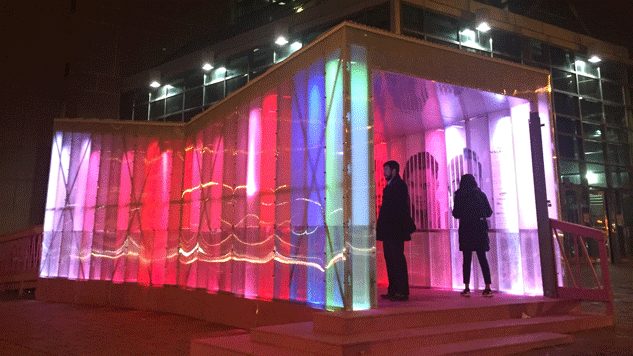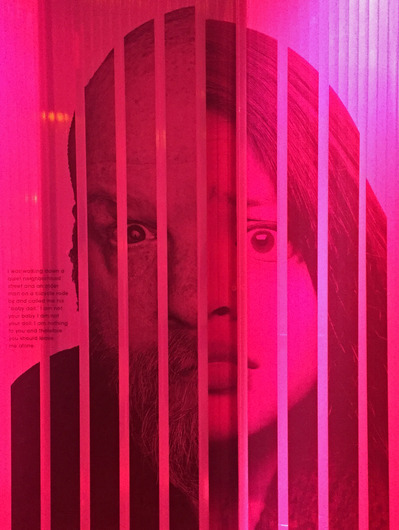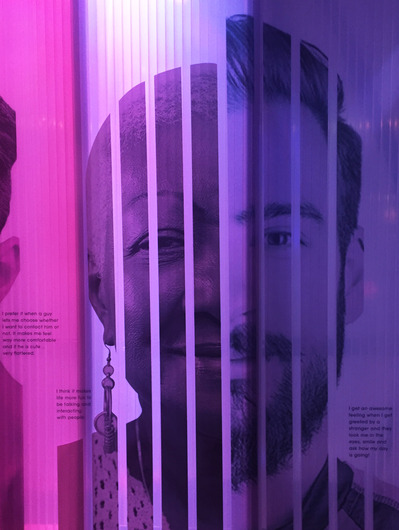D.C. Confronts Street Harassment With Architectural Intervention
Photos by Erik Moe Design Features Marshall Moya Design
An installation in Washington, D.C. aims to provoke awareness of street harassment using architecture, sound, light, images, and stories. The Walkway was developed by Marshall Moya Design as part of Washington Mayor Muriel Bowser’s ‘Vision Zero’ initiative to eliminate transportation-related fatalities. Exposure to street harassment is a significant factor in how residents choose to navigate the city, with pedestrians and cyclists often making unsafe choices to avoid verbal or physical harassment.
The Walkway activates an often-neglected public plaza at the busy intersection of 14th and U Streets NW. The fluid motion of its magenta and blue exterior lighting draws curiosity-seekers (and their Instagram posts) during the long darkness of winter evenings—no simple task for an outdoor project on a complex social issue when most passers-by are focused on getting inside to warm homes or nightlife destinations.
Once drawn inside the structure, the polished exterior experience gets more complicated. The interior takes the form of a Venturi tunnel—wherein the middle of the structure is tighter and more constricted than the wide, welcoming openings at either end. The designers intended effect is to mimic the sense of tension and claustrophobia we feel as we hurry past a point of confrontation on the sidewalk. The effect is an illustration of how design choices shape our psychological state in ways that are often overlooked. In The Walkway, the effect is subtle, perhaps because there are a lot of other things going on in the space that slow viewers down and shape our engagement with it.

The first thing you notice inside is a series of large black and white faces. These have have been cut in to vertical slices and reconfigured such that identity is blurred across gender, age, race, and culture. Alongside these disorienting faces are stories of sidewalk behavior between strangers—some hostile, some affirming, and some that are more complicated to read in to. By putting these stories alongside faces that are difficult to read, it becomes unclear who is telling the story. We don’t know if we’re reading a male, female, gay or straight voice. We don’t know if we share the same body type, self image, or sense of safety in public as the quote’s speaker.
This subtle disorientation puts viewers in the position of both victim and perpetrator, but also of good neighbor, of voyeur, and of the passer-by who does nothing in the face of harassment. To the degree that this effect worms its way in to the heads of those who physically or verbally assault women on the street, The Walkway will have an impact.

The experience is amplified further by a motion-activated soundtrack that includes street noise and examples of the kind of language that makes public space hostile. Unfortunately, situated on this busy intersection where everyday noise and harassment is common, this element might be completely redundant. It has also been the most controversial aspect of the project. Jessica Raven, executive director of Collective Action for Safe Spaces—an advocacy group for victims of assault—criticized the audio as being a psychologically dangerous trigger for victims who might be drawn in to the colorful installation unprepared (there is a trigger warning atop large explanatory panels at both entrances, but it can be easily missed).
Zarela Mosquera of Marshall Moya Design said, “our installation seeks to engage people in conversations about how strangers act towards each other in public places. Sometimes these interactions can be very positive and friendly. But sometimes, seemingly harmless interactions can have adverse affects and can quickly escalate into frightening and dangerous encounters. In creating the piece, we wanted to make it clear how harmless experiences may be perceived as threatening, which is why The Walkway is open and narrows very quickly in a few steps.”
The project is also collecting reactions and data about street harassment via its website, wlkway.com.
“We hope that by raising awareness and encouraging open and honest discourse we can inspire respect and understanding in public places, where we should feel safe and connected to each other,” said Zarela.
The Walkway is installed at the intersection of 14th and U Streets NW in Washington, DC through March 1.